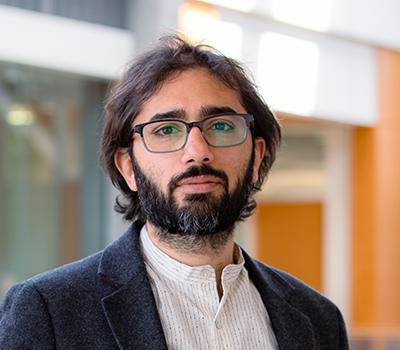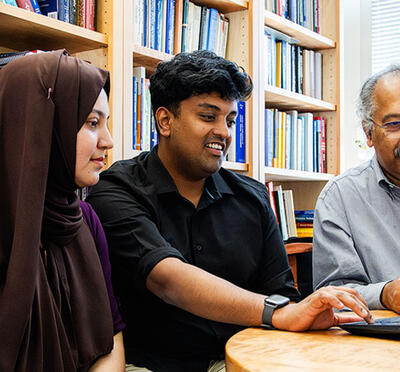The race is on to bring back semiconductor manufacturing in the U.S. The industry got a huge boost from the federal CHIPS and Science Act in 2022, which invested $52.7 billion in the industry. Oregon followed with its own CHIPS Act in 2023, adding another $240 million. These investments are anticipated to spur rapid growth of the state’s semiconductor industry.
But there’s a problem: Oregon does not have enough people trained for semiconductor careers, according to the Semiconductor Workforce and Talent Assessment commissioned by Oregon’s Higher Education Coordinating Commission. The report estimates the semiconductor sector in Oregon will grow by 6,300 new positions, driving the need for a 24% increase in workers with semiconductor-related credentials.
Leaders in the College of Engineering at Oregon State University are improving and expanding educational pathways to fill this crucial workforce gap. The college’s role in innovating solutions is recognized by industry leaders and state officials.
“Oregon State is providing critical leadership by creating sustained partnerships and collaborations that advance workforce strategies to meet the industry’s needs,” said Kyle Ritchey-Noll, education and workforce policy director at the Oregon Business Council.
Grounded in a long history of educating top engineers working in the semiconductor industry, Oregon State has a good start on filling the workforce gap. Faculty members are working closely with industry partners and other universities to develop programs and curricula that will attract more students to the field and prepare them to enter the workforce.
Sparking interest in semiconductor careers
Many young Oregonians are missing out on well-paying careers because they do not know they exist. The semiconductor workforce includes a broad range of education levels, from high school diplomas to doctoral degrees. The average annual wage in 2022 for Oregon employees in semiconductor and related device manufacturing industries was $171,750, more than twice the statewide average for all careers.
To raise awareness of semiconductor careers, the College of Engineering hosted a pilot program in Fall 2024 for 16 incoming students, called the OSU CHIPS Lab. The weeklong residential program, supported by Micron and the Northwest AI Hub, included hands-on lab work in the on-campus cleanroom, a tour of HP’s facilities in Corvallis, and professional development workshops with speakers from semiconductor companies and academia. Activities from the program have been incorporated into a first-year engineering course.
“I didn't know anything about semiconductors when I came here,” said Violet Gualotunia, a chemical engineering student who participated in the program. “Working in the clean room is so interactive and it's exciting because there's so many new things to learn about.”
Analog Devices Inc., with support from the College of Engineering, hosted a two-week intensive workshop on semiconductor manufacturing for first-year undergraduate students last summer. The program was held in Beaverton at ADI’s Semiconductor Advanced Manufacturing Upskilling training center, which serves ADI employees, students, educators, and the larger semiconductor equipment technician population. The workshop, open also to K-6 educators, included virtual reality training, theoretical lectures, and hands-on experiments with semiconductor equipment and robotic systems.
“We’re committed to building the talent that will be the future of the semiconductor industry,” said José García, managing director at ADI who organized the workshop. “Having the right skilled workforce is essential for continuing to drive innovation.”
The experience provided an opportunity to get students thinking about semiconductor careers early on — even before they are ready to do an internship.
“I wish more companies would do short, exploratory programs like this one,” said Louis Laventall, an industrial engineering student who attended. “It excites current engineering students to open their horizons to industries they have never been previously exposed to.”
Modernizing semiconductor design courses
Although the focus of the federal and state CHIPS acts is to bring back semiconductor manufacturing to the U.S., keeping students up to date on design technologies is also critical.
"I think the whole area of design is overlooked when people think about the semiconductor industry. But it's the area where the U.S. has its greatest dominance and maintain our competitive lead in design is very important," said Tom Weller, head of the School of Electrical Engineering and Computer Science and the Michael and Judith Gaulke Chair in Electrical Engineering and Computer Science.
Oregon State faculty members are revamping several integrated circuits courses with help from companies like Cadence and Intel. The updates are part of a collaborative effort with faculty at other universities — including Duke University, the University of California (Berkeley and Davis), and the University of Hawaii — to co-develop courses for more consistency across universities. That collaboration is enabled by the Northwest AI Hub, which supports academic, industry, government, and non-profit member organizations to advance research and education in semiconductors.
“The fundamentals of VLSI circuits haven’t changed, but students need to be aware of newer technologies like FinFETs,” said Matt Johnston, associate professor of electrical and computer engineering who updated the core VLSI circuit design course and is developing a follow-on class.
There is also a need in the semiconductor industry for people who can do hardware verification — making sure the design meets all the specifications. When companies like Apple and Cadence recommended that Oregon State offer a class dedicated to verification, Houssam Abbas, assistant professor of electrical and computer engineering, was on board to develop a new course. Abbas knew this workforce gap existed from his years with Intel, where he worked in the computer-aided design group doing system-on-chip verification. So, he had already added verification material into his VSLI design course.
“We now have a full class on register-transfer level verification, which covers the major techniques, including an emphasis on formal verification, which is an approach that is extremely powerful, very sought after, and not sufficiently taught at the undergraduate level,” Abbas said.
Filling needs faster with semiconductor microcredentials
Building a pipeline for careers in semiconductors will take time that companies don’t have. To meet immediate needs for a trained workforce, Oregon State has developed bite-sized degrees, called microcredentials, composed of three or four courses.
The College of Engineering, in partnership with Oregon State Ecampus, offers four semiconductor-specific microcredentials, with another four on the way. The microcredentials are available to anyone who meets the prerequisites, with courses offered on campus and online. The program serves two purposes: quick upskilling for professionals and semiconductor specialization for Oregon State undergraduates.
The first microcredentials to roll out are process engineering analysis, process engineering fundamentals, programming fundamentals, and semiconductor production process planning. Next year, semiconductor facilities design management will be available. Another three in development are semiconductor devices, semiconductor fabrication, and applied data science.
"We’ve created something that employees or graduating students can show to employers to demonstrate they have received training that is relevant for a semiconductor job,” Weller said.
Students receive a digital badge they can share on LinkedIn and other social media platforms to demonstrate completion of a microcredential.
Expanding opportunities for veterans
Military veterans will soon benefit from a $1 million award to Oregon State from the Higher Education Coordinating Commission. The Workforce Ready Grant, called VETS-UP, will provide veterans with training for careers in the semiconductor industry. The eight-week training program will be hosted by ADI twice a year for two cohorts. ADI and several other industry partners are providing internships and guidance on the program design. Participants will also receive Oregon State credit that can be applied toward a degree if they choose to continue their education.
“The skills learned in the military services often translate directly to job requirements in the semiconductor industry, so veterans are highly sought after for technician and engineering positions,” said Weller, who is the principal investigator for the project. “We are thrilled to offer this program as part of our broader efforts in connecting Oregonians with lucrative careers and expanding the semiconductor workforce.”
Growth on the horizon
Across Oregon, organizations are rallying to support the growth of semiconductor manufacturing by partnering with Oregon State on the CorMic Tech Hub and the FAST Regional Innovation Engine. Both consortiums include numerous partners in academia, community organizations, industry, and government. The groups are united in a mission to stimulate the economy of Oregon and help individuals to improve their lives through better job opportunities.

The CorMic Tech Hub, led by Oregon State, received $45 million in early 2025 to advance microfluidic technologies, which have applications for semiconductors and biotechnology. The Tech Hub will be located in Corvallis at the HP campus, where Oregon State faculty and students will collaborate with industry partners, including Intel, NVIDIA, and Siemens, on technology development.
Oregon State is also leading the FAST Regional Innovation Engine, a National Science Foundation-designated consortium of over 70 organizations across the state. One of FAST’s primary goals is to recruit and train a larger workforce by implementing programs in K-12 schools, community colleges, and universities.
A regional commitment to this goal was evident at the Oregon Semiconductor and AI Innovation Summit, which focused on partnering with FAST. The capacity crowd of 300 participants from more than 200 organizations included 36 C-Suite leaders. The collaborative event was co-hosted by the Technology Association of Oregon, Oregon State University, and Intel Corp., with additional sponsorship from Synopsys and Provenance Chain Network.
The broad engagement with these large initiatives demonstrates a willingness for a variety of organizations to collaborate on developing a clear pathway for semiconductor careers in Oregon.
“Oregon faces a generational opportunity to prepare talented, diverse Oregonians across the state for high-wage, meaningful careers in the semiconductor industry, while meeting the competitive talent needs of the industry and creating a workforce that outcompetes anywhere in the world,” Ritchey-Noll said.




